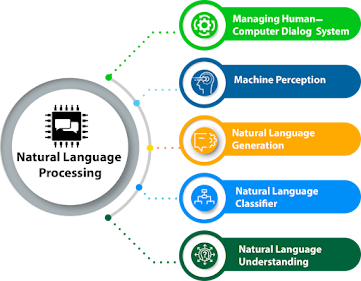Natural language processing (NLP) is a machine learning technology that gives computers the ability to interpret, manipulate, and comprehend human language. Organizations today have large volumes of voice and text data from various communication channels like emails, text messages, social media newsfeeds, video, audio, and more. They use NLP software to automatically process this data, analyze the intent or sentiment in the message, and respond in real time to human communication.
Why is NLP important?
Natural language processing (NLP) is critical to fully and efficiently analyze text and speech data. It can work through the differences in dialects, slang, and grammatical irregularities typical in day-to-day conversations.
Companies use it for several automated tasks, such as to:
- Process, analyze, and archive large documents
- Analyze customer feedback or call center recordings
- Run chatbots for automated customer service
- Answer who-what-when-where questions
- Classify and extract text
You can also integrate NLP in customer-facing applications to communicate more effectively with customers. For example, a chatbot analyzes and sorts customer queries, responding automatically to common questions and redirecting complex queries to customer support. This automation helps reduce costs, saves agents from spending time on redundant queries, and improves customer satisfaction.
What is natural language processing used for?
Some of the main functions and NLP tasks that natural language processing algorithms perform include the following:
- Text classification. This function assigns tags to texts to put them in categories. This can be useful for sentiment analysis, which helps the natural language processing algorithm determine the sentiment, or emotion, behind a text. For example, when brand A is mentioned in X number of texts, the algorithm can determine how many of those mentions were positive and how many were negative. It can also be useful for intent detection, which helps predict what the speaker or writer might do based on the text they're producing.
- Text extraction. This function automatically summarizes text and finds important pieces of data. One example of this is keyword extraction, which pulls the most important words from the text, which can be useful for search engine optimization. Doing this with natural language processing requires some programming -- it isn't completely automated. However, there are plenty of simple keyword extraction tools that automate most of the process -- the user just sets parameters within the program. For example, a tool might pull out the most frequently used words in the text. Another example is entity recognition, which extracts the names of people, places and other entities from text.
- Machine translation. In this process, a computer translates text from one language, such as English, to another language, such as French, without human intervention.
- Natural language generation. This process uses natural language processing algorithms to analyze unstructured data and automatically produce content based on that data. One example of this is in language models like the third-generation Generative Pre-trained Transformer (GPT-3), which can analyze unstructured text and then generate believable articles based on that text.
The functions listed above are used in a variety of real-world applications, including the following:
- Customer feedback analysis. Tools using AI can analyze social media reviews and filter out comments and queries for a company.
- Customer service automation. Voice assistants on a customer service phone line can use speech recognition to understand what the customer is saying, so that it can direct their call correctly.
- Automatic translation. Tools such as Google Translate, Bing Translator and Translate Me can translate text, audio and documents into another language.
- Academic research and analysis. Tools using AI can analyze huge amounts of academic material and research papers based on the metadata of the text as well as the text itself.
- Analysis and categorization of healthcare records. AI-based tools can use insights to predict and, ideally, prevent disease.
- Plagiarism detection. Tools such as Copyleaks and Grammarly use AI technology to scan documents and detect text matches and plagiarism.
- Stock forecasting and insights into financial trading. NLP tools can analyze market history and annual reports that contain comprehensive summaries of a company's financial performance.
- Talent recruitment in human resources. Organizations can use AI-based tools to reduce hiring time by automating the candidate sourcing and screening process.
- Automation of routine litigation. AI-powered tools can do research, identify possible issues and summarize cases faster than human attorneys.
- Spam detection. NLP-enabled tools can be used to classify text for language that's often used in spam or phishing attempts. For example, AI-enabled tools can detect bad grammar, misspelled names, urgent calls to action and threatening terms.
Benefits of natural language processing
The main benefit of NLP is that it improves the way humans and computers communicate with each other. The most direct way to manipulate a computer is through code -- the computer's language. Enabling computers to understand human language makes interacting with computers much more intuitive for humans.
Other benefits include the following:
- Offers improved accuracy and efficiency of documentation.
- Enables an organization to use chatbots for customer support.
- Provides an organization with the ability to automatically make a readable summary of a larger, more complex original text.
- Lets organizations analyze structured and unstructured data.
- Enables personal assistants such as Alexa to understand the spoken word.
- Makes it easier for organizations to perform sentiment analysis.
- Organizations can use NLP to better understand lead generation, social media posts, surveys and reviews.
- Provides advanced insights from analytics that were previously unreachable due to data volume.






No comments:
Post a Comment